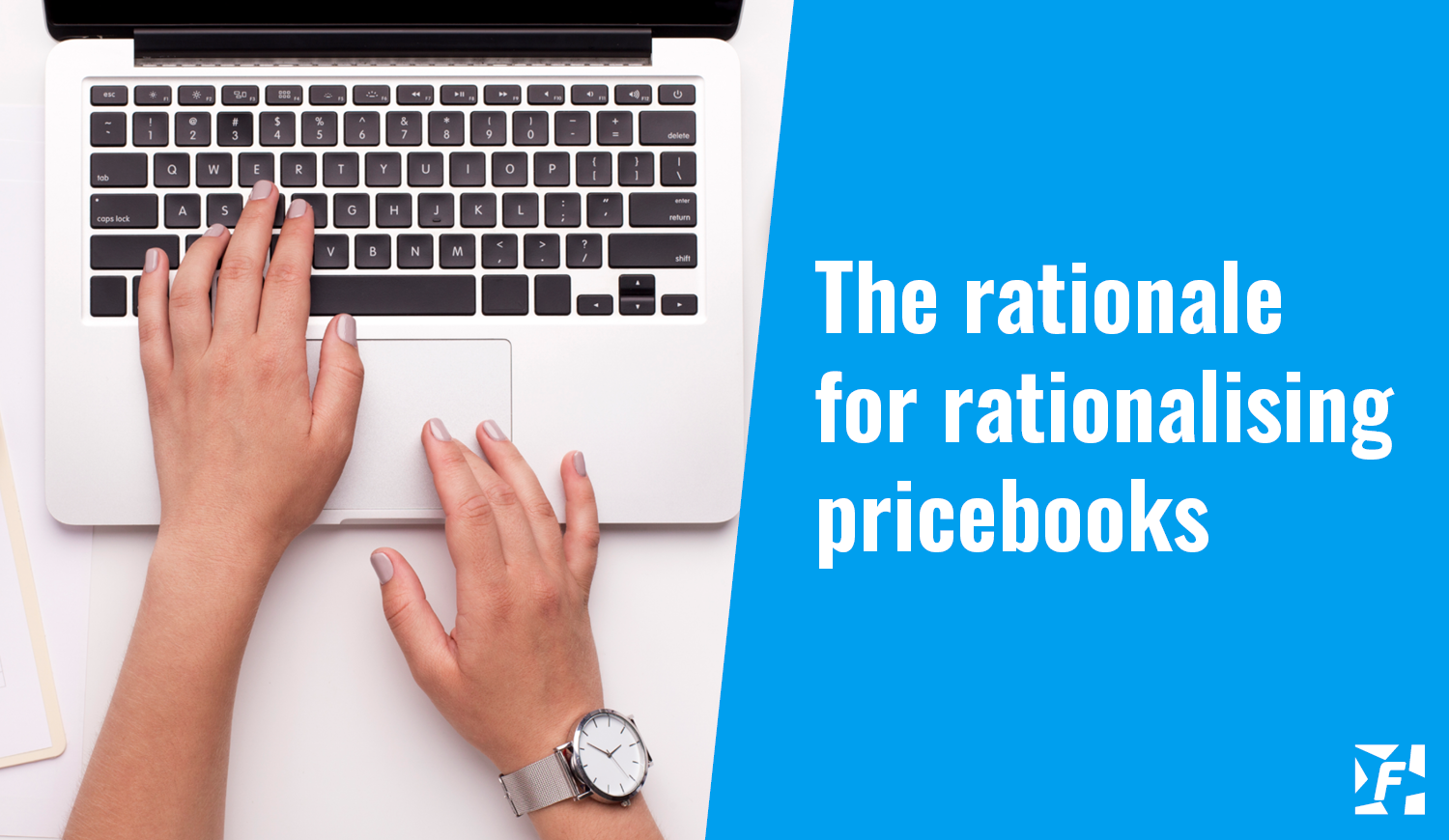The rationale for rationalising pricebooks
Aside from the obvious pricing and selling benefits of using Flexpricer, one of the main administrative reasons for using the platform is to rationalise pricebooks. And by that, I mean…
REDUCE THE NUMBER OF PRICEBOOKS THAT YOU USE
It is so easy to waste hours and hours of your life trying to maintain tens or hundreds of pricebooks that mean you have tens of thousands of pricebook entries to look after too.
Flexpricer can help you substantially reduce the number of pricebooks that you need to use and the opportunity of launching Flexpricer presents and ideal (!) time to do this.
Our Goal Is: One Master Pricebook
In an ideal world, you would have one, master pricebook that lists your products and their list prices.
Now, I know that in some businesses that’s not realistic because you specifically want to present certain products in certain regions/sectors etc. But my challenge to you is to search for ways to absolutely minimise the number of pricebooks you have and to NOT create pricebooks just to offer different prices.
Your aim for pricebooks is to only use different pricebooks when you need to offer different products – not different prices.
So, if I were to suggest considering that you were only allowed to have one pricebook, that contained all of your products… would you be able to create that pricebook and set all the list prices?
Flexpricer allows you to tweak prices and discounts on a per-account basis, and it’s these features that we’ll look to leverage to ensure that your customer gets the right price every time they order… even if you only have one pricebook!
Use Cases
There are many different ways that businesses use pricebooks, however we see repeating patterns.
In the category, we walk through a series of specific steps on how to reduce the number of pricebooks when the number of them has grown as a result of certain use cases.
We cover….
- An explanation of the use case so that you can see whether your business suffers from this
- The Flexpricer Features to use to reduce the number of pricebooks
- The specific setup steps to undertake to enable this
- A migration checklist of how to move accounts from using legacy pricebook to the new ‘master’ pricebook
- Risks to Manage – because nothing goes smoothly 100% of the time!
When Would Multiple Pricebooks Be Necessary
After installing Flexpricer, the idea that you could rationalise all your pricebooks into one could turn into a reality.
However, there are some circumstances when you just do need to maintain multiple pricebooks.
The only REALLY GOOD reason to maintain multiple pricebooks though is when comparing them, the percentage difference in product prices is materially different for each product such that it is difficult to draw a pattern between prices. For example
- Product A
- Pricebook 1: £9,750
- Pricebook 2: £7,921 (18.7% lower)
- Product B
- Pricebook 1: £47
- Pricebook 2: £873 (1,857% higher)
- Product C
- Pricebook 1: £5,000
- Pricebook 2: £5,000 (the same)
This scenario might be the case if you price individual products radically differently in different markets (e.g. prices in France vary on a product-by-product basis to prices in Germany)
Commonly, businesses create Retail Pricebooks and Trade Pricebooks to separate out prices between retail customers and trade customers. However, if your use case is that trade customers get a fixed percentage discount from the retail pricebook (e.g. 20% off), then Account Discount should be used in preference to maintaining the additional pricebook. This gives you the flexibility to offer or change the discounts offered to trade customers without creating a new pricebook.
Bad Reasons (Excuses) To Maintain Multiple Pricebooks
- Maintaining products in multiple currencies is NOT a good reason to maintain multiple pricebooks since you can create prices in different currencies within the same pricebook.
- Making customer-specific pricebooks is RARELY a good reason to maintain multiple pricebooks. The only time that you should consider this if the vast majority of the products in a pricebook will be priced at different percentages from the master pricebook. Otherwise, you can use combinations of Account Discount, Client Pricing and Matrix Pricing.
- Creating region-specific pricebooks is RARELY a good reason to maintain multiple pricebooks unless customers can buy in multiple regions and should receive different price depending on the region OR if regional prices are not a common percentage different to the master pricebook (which prevents Account Discount from being used).
IMPORTANT: If you do maintain multiple pricebooks, try to use Account Pricebook to ensure that customers who should always receive a certain pricebook get it automatically allocated to newly created opportunities.
Pricebook Rationalisation Checklist
The simple checklist below gives you the steps to perform when rationalising pricebooks.
- Identify the MINIMUM number of pricebooks that you can use in your organisation. This is probably the hardest non-technical step to make.
- Create a master pricebook that contains all your products with all the list prices as the starting point.
- Migrate accounts across to the master pricebook in a controlled way, creating the necessary client price, matrix price adjustments and account discounts
- Set the Master Pricebook as the Account Pricebook on Account being migrated
- Use Account Pricelist to validate the prices on migrated accounts against those in their current pricebook



